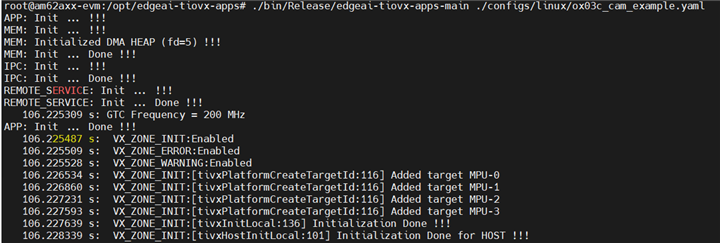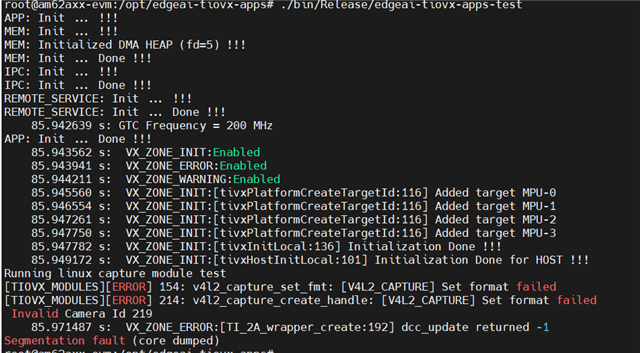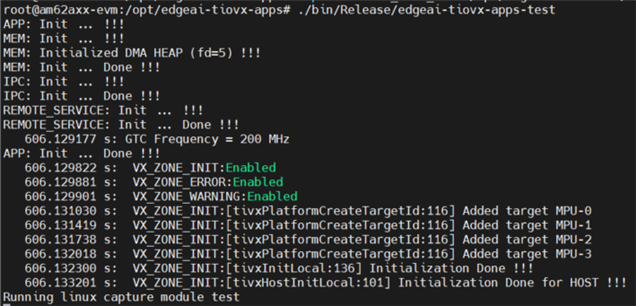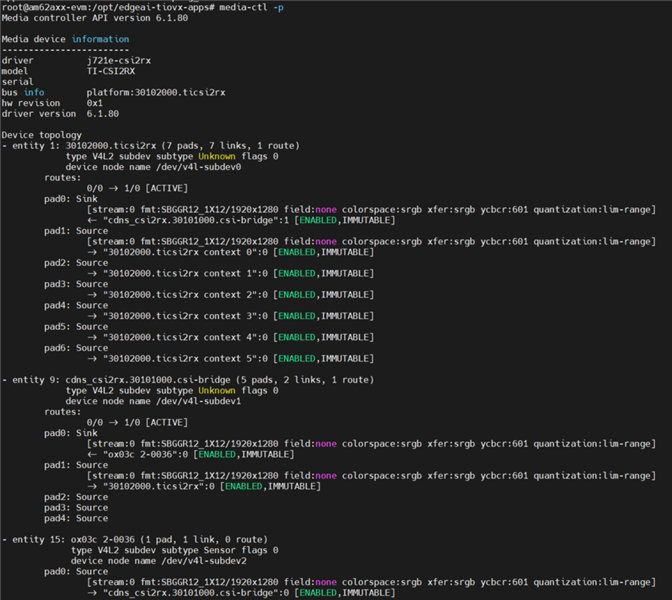Tool/software:
Dear Ti support,
Recently I'm trying to port our sensor to edgeai-tiovx-apps on AM62A. The major modifications are as follows:
In input_block.c, new case is added for our sensor.
else if (0 == strcmp("ox03c",input_info->sensor_name))
{
sprintf(sensor_name, "SENSOR_OX3C");
format_pixel_container = TIVX_RAW_IMAGE_16_BIT;
format_msb = 11;
v4l2_pix_format = V4L2_PIX_FMT_SBGGR12;
output_width = 1920;
output_height = 1280;
}
In tiovx_sensor_module.c, again new case for the sensor.
else if(strcmp(sensorObj->sensor_name, "SENSOR_OX3C") == 0)
{
sensorObj->sensorParams.dccId=233;
}
Somehow when running the following script, the output didn't show any error while there is no output in the screen:
The yaml in use is as follows:
title: ox03c Camera
inputs:
input0:
source: LINUX_CAM
width: 1920
height: 1280
sensor-name: ox03c
device: /dev/video3
subdev: /dev/v4l-subdev2
ldc: False
models:
model0:
model_path: /opt/model_zoo/TFL-CL-0000-mobileNetV1-mlperf
topN: 5
model1:
model_path: /opt/model_zoo/ONR-OD-8200-yolox-nano-lite-mmdet-coco-416x416
viz-threshold: 0.6
model2:
model_path: /opt/model_zoo/ONR-SS-8610-deeplabv3lite-mobv2-ade20k32-512x512
alpha: 0.6
outputs:
output0:
sink: LINUX_DISPLAY
width: 1920
height: 1080
output1:
sink: H264_ENCODE
width: 1920
height: 1088
output_path: /opt/edgeai-test-data/output/output_video1.h264
output2:
sink: IMG_DIR
width: 1280
height: 720
output_path: /opt/edgeai-test-data/output/
flows:
flow0:
pipeline: [input0,null,output0]
mosaic:
- [0,0,1280,720]
and the app printed these:

I've also tried the image input, whether outputing in the screen or generating files, it works just fine.
title: Image Classification
inputs:
input0:
source: RAW_IMG
width: 1280
height: 720
format: NV12
image_path: /opt/edgeai-test-data/raw_images/tiovx_apps/
models:
model0:
model_path: /opt/model_zoo/TFL-CL-0000-mobileNetV1-mlperf
topN: 5
model1:
model_path: /opt/model_zoo/ONR-CL-6360-regNetx-200mf
topN: 5
outputs:
output0:
sink: LINUX_DISPLAY
width: 1920
height: 1080
output1:
sink: H264_ENCODE
width: 1920
height: 1088
output_path: /opt/edgeai-test-data/output/output_video0.h264
output2:
sink: IMG_DIR
width: 1280
height: 720
output_path: /opt/edgeai-test-data/output/
flows:
flow0:
pipeline: [input0,null,output2]
mosaic:
- [0,0,1280,720]
I think the major problem is from the sensor related configurations, as the above configuration can utilize the LINUX_DISPLAY correctly. So I compared related configurations in both gsttiovxisp.c and edgeai-tiovx-apps. The problem here is that there are so many different struct definitions, making it hard to pin-point the differences in the initialization and configuration process. Would you please give me some hint about what to pay attention to?
BTW, the gstreamer pipeline works fine so there shouldn't be anything wrong with the sensor.
Regards,
Huang Jingjie




